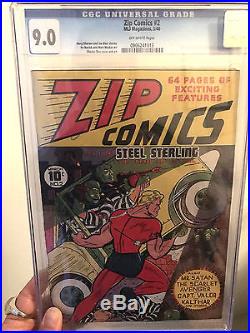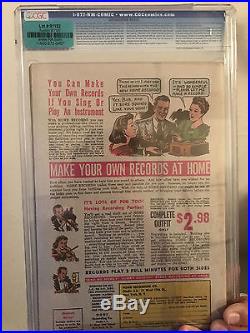



Zip Comics #2 (MLJ, 1940) CGC VF/NM 9.0 Off-white pages. This is the best copy we’ve ever offered of a book that’s interesting in a couple of respects. The March 1940 cover date puts it early in the superhero era Hour-Man debuted in. #48 of the same month. Also, while Steel Sterling was the first hero to be called “The Man of Steel, ” his cover outing here does have similarities to. With the high grade on this copy, it seems surprising that this book doesn’t hail from one of the more prominent Golden Age pedigrees. CGC census 8/15: 1 in 9.0, 1 higher. Zip Comics was published by MLJ Magazines Inc. The precursor to what would become the publisher Archie Comics. In common with MLJ’s other three main anthology titles, Blue Ribbon Comics. Zip Comics contained a mixture of superhero and costumed hero adventure, mystery, war, detective and fantasy strips. The series was edited by Harry Shorten. The feature story in every issue was the superhero “Steel Sterling the Man of Steel”. Drawn by Irv Novick and originally written by Abner Sundell. Later issues were written by Joe Blair. Steel Sterling was supported by a number of other long-running series, the war adventure “War Eagles, the Devil’s Flying Twins” (#127) by Ed Smalle, concerning two young American airmen who join the Royal Air Force. To continue a feud with a German pilot who was their fencing adversary; “Captain Valor”‘the hard-bitten adventurer’ by Mort Meskin. (#126), who’resigns his commission in the U. Marine Corps to seek adventure, because the Marines are no longer exciting enough for him. And heads for the Far East; the costumed crime-fighting magician “Zambini the Miracle Man” (#135), called “The Miracle Man, Zambini the Magician” in issue #1 only, by Ed Wexler, “Nevada Jones, Quick Trigger Man” (#125), a’cowboy Cattle Detective’ forced to become a masked outlaw doing good in secret after being framed for murder; and the masked gangbuster “Scarlet Avenger” (#117). These stories were accompanied in early issues by “Kalthar the Giant Man”‘King of the Jungle’ (#19) by Lin Streeter and the adventurer “Mr Satan” (#19) an’International Detective and Soldier of Fortune’. Both these stories were replaced from issue #10 by the fantasy fairy tale “Dicky in the Magic Forest” (#1026) by Lin Golden and “Red Reagan of the Homicide Squad” (#1019). In the early Zip Comics there was only one humor strip, “Mugsy” by Kim Platt (#1-#6), about a dog who always ended up back in the pet shop window because of his escapades. From issue #18 (September 1941) a new strip, “Wilbur”, replaced the “Scarlet Avenger”. Published four months before MLJ’s most successful character, Archie Andrews. , Wilbur was also a teen humor strip that outlasted his home title, graduating to his own long-running series in 1944 after appearing for the rest of the Zip Comics run. He was soon joined by two other costumed heroes, “Black Jack” (#2035) who replaced Red Reagan, and, replacing “Nevada Jones”, “The Web” (#2738) who was also the subject of text stories in most issues he featured in. Three issues during this period contained one-off supernatural tales, “Stories of the Black Witch”, while “Zip’s Hall of Fame” in most issues from #2838 began with heroic stories of wartime American servicemen, but soon moved to the war exploits of a Russian female patriotic hero, Maria Baida. An Irishman fighting in China, Serbian guerrilla resistance leader Draza Mihailovic. A 72-year-old female Serb Chetnik. Guerrilla fighter, Drina Cachalka in issue #34, and Russian military hero Marshal Timoshenko. Although issue #33 Jan. 1943 also contained the only “Zip’s Hall of Shame”, about German. Eventually, as part of MLJs change in editorial policy from superheroes towards humor comics, although “Steel Sterling” retained his place in Zip Comics , in issue #35 (March 1943) “Wilbur” was joined by teen humor strip “Ginger”, and in the following issues MLJ replaced the other costumed heroes with further humor content, such as funny-animal characters “Chimpy”, “Woody the Woodpecker” not the same as the better-known Woody Woodpecker. Character, “Senor Banana” a comic strip with a continuing storyline, and country folk “The Applejacks”, together with text stories of both “Ginger” and “The Applejacks”. From then on until the end of the series only one other non-humor strip ran in Zip Comics , orphan Rueben Rueben, “Red Rube”, a superhero who could call on the powers of his ancestors (who were all called Reuben Reuben) by saying’Hey Rube’ , and who replaced Steel Sterling as the star on the cover from his first issue, most in a humorous style instead of the war/adventure scenarios of the earlier Steel Sterling Zip Comics covers. The series ended with issue #47, and has not been revived since. However, in August 2009 Michael Uslan. Announced that five one-off comics reviving the Archie-as-superhero’Pureheart’ concept would be released in 2010. One of those titles being Zip Comics. The item “Zip Comics #2 (MLJ, 1940) CGC VF/NM 9.0 Off-white pages RARE Golden Age Comic” is in sale since Monday, April 10, 2017. This item is in the category “Collectibles\Comics\Golden Age (1938-55)\Superhero”. The seller is “vidurainc” and is located in New York, New York. This item can be shipped worldwide.
- Certification: CGC
- Grade: 9
